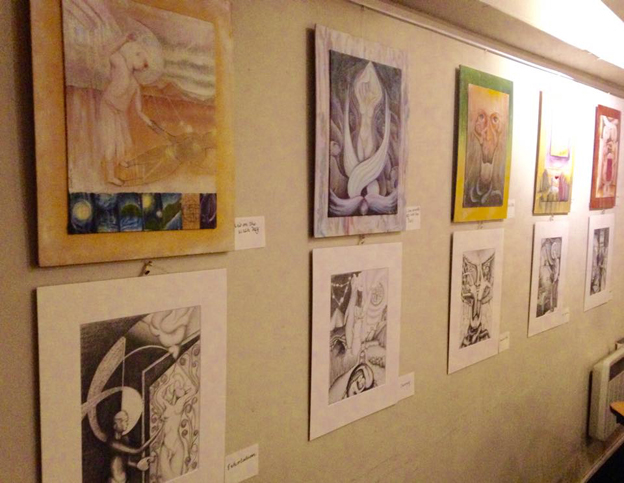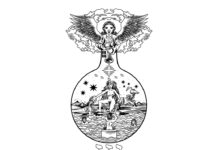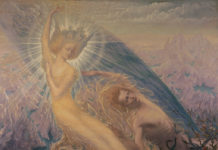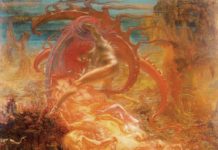In my introductory post I gave an outline of how I came to study Péladan’s work, along with a list of what has emerged from those studies. What few people realise, since I approached Péladan as a scholar, is that the primary reason I entered esoteric studies was because first, I was an artist looking for a purpose.
I originally went to an independent art school in Athens (Greece), which back in my late teens, was a dream come true. But I didn’t get on well there; it was not intellectually stimulating enough for me, and Greek art schools tend to focus on a painterly form of expressionist modernism that I found very limiting (the painting below is one of my early works reflecting the style they wanted us to develop – I, on the other hand, dreamed of the Renaissance…). I also wanted art to mean something, and for technique and symbolic content to match each other in depth and quality. So, after leaving art school, aged 21, I began creating works that drew on my scattered knowledge of mythology and philosophy, and my long-standing obsession with the story of fallen angels – which I can’t really explain.
However, I was missing a system, a proper vocabulary that would enable me to tell stories with my art, that would connect it to a deeper current of meaning, and that would make it meaningful to the viewers who could read it. I was so very young, and my art was limited by my equally restricted life experience and knowledge – so it largely reflected my limited worldview. For some artists, that is still rich in content. For me, it was not enough. I needed a purpose.
By chance, I discovered the MA in Western Esotericism, and the rest is history. By the time I came to study Péladan at doctoral level, I was a fully-fledged scholar. Yet I was still painting; dividing my time between my desk and my easel, exhibiting periodically as I continued my studies, and promising myself an overdose of art when I was finally done. I have been attempting to balance my artistic, scholarly, and day-job lives since I turned 18… After 25 years, I think I may be getting there.
As I delved deeper into Péladan’s work, I realised I’d really discovered a kind of Holy Grail for artists – precise instructions in how to make art everything I had thought it should be – long before I’d ever heard of either Péladan or esotericism. Then I realised the man had written a whole manifesto, and a separate handbook, especially for artists who thought that way. Surely then, this was a sign?
Scholars often get a bad rap from practitioners, and in the 20 or so years that I have been active in the esoteric community – scholarly and practical both – I have had many fraught discussions and fought many battles, especially when I am met with assumptions from either side – academic or practitioner – supposing that I have “gone native” on the “wrong” side. Since 2009 I have strongly asserted that scholars and practitioners do not need to be at odds, since they each have entirely different purposes and end-goals. This seemed quite obvious to me as an artist already, because learning art history does not mean you are “selling out” as a creative, and being an active artist does not mean you cannot also be well-read in art history. It would be preposterous to suggest as much. And it is quite honestly preposterous to suggest that a scholar cannot also be a practitioner, or vice versa. They will only be a good scholar, mind you, if they can respect the rules of academia when wearing their scholar’s hat, and be true to themselves when practicing. But the two are not mutually exclusive – unless ideology or ignorance get in the way. Ditch the one, be self-aware enough to avoid the other, and this should be a non-issue.
When I say this, I often get asked, sometimes furtively, sometimes timidly, often aggressively, “what is your practice?” My answer is nearly always “that is none of your business,” though enough people know that I have a certain amount of experience in what one might call a traditional initiatory setting. However, the answer I give when I’m frustrated enough, is that “I am an artist, and that is practice enough.”
That response is usually met with blank gazes, at which point the conversation usually peters out. Unless there are other creatives in the room, at which point we exchange looks of mutual sympathy.
Unless you are an artist (of any stripe – writers, musicians, sculptors, craftspeople, and painters are all artists), you may not be aware of the deep meditative state that being in the “creative zone” entails, nor what it does to your mind. Icon painters in the Eastern Orthodox tradition are instructed to make good use of this zone, in which they are believed to be serving God, channeling divine Will, and “writing” the icon, whereby their arm and paintbrush are literally seen to be “creating living theology.” It is truly trance-like, and something strange happens to your consciousness when you’re in that place. You know you’re there, because time slips by like water, your mind slows, and you begin to see with different eyes. Artists are born to this even when they don’t concentrate on sacred art. But unless they harness it and develop their skills, or if they do hone those skills but get swallowed by the commercial art scene, it may not result in anything; indeed it may torment them.
Going through the discipline of artistic training is an initiation all in itself – not necessarily an esoteric one, but it disciplines the eye, the mind, and the hand, all the same. You become conscious of your body in a way you were not, of different kinds of seeing, and different layers of perception. You must be able to communicate without words, and there are no short-cuts for doing that with aesthetic and technical quality. You become intimately familiar with the workings of your mind, and how the physicality of creation interacts with it. You have no words, so you must generate an image that can speak. That’s something the ancient Greeks did as a matter of course, and it is something icon painters and Byzantine artists still do. I had been trained in that tradition, and turned away from it, in my late teens. At that point, just pushing 30 at the time, I returned to it, realising I had had the tools to achieve my aims, but had been too green to acknowledge their value.
Having already undergone the skills training, I found myself needing the mental discipline. That’s what academia gave me. It was never a case of either/or, it is a case of both/and – which, incidentally, every Rosicrucian adept from Maier to Péladan insist is vital anyway. This also gave me the keys to the visual vocabulary I needed to paint pictures that tell stories and touch places of inner knowing that cannot be reached by other means, and showed me the pathways to the sources that allowed me to build richly layered visual narratives.
It was after this realisation that I discovered Péladan, who gave me a set of instructions on how to make those pictures serve a specific purpose, and in so doing, turn my innate talent to something meaningful, that might inspire others.
In parallel, I continued my research. Switching from careful historical documentation of Péladan’s influences, life, and work, to creating art according to his instructions, was as easy as taking off a business suit and putting on an evening outfit. All it really requires is self-awareness and time management. The one is inappropriate for the office, the other looks ridiculous in a bar. It’s something we all do in different settings, and I therefore remain bemused by the animosity I often encounter towards academics on the part of practitioners – since it is obvious that it comes from a place of ignorance.
In 2013 I was entering my final PhD year, but had endured family illnesses in the role of caregiver that had left my world shaken. I was given 6 months of leave from my university to deal with this. When circumstances improved, to pull myself together, I turned to art. At the time I hadn’t worked for over 6 months, had just moved house, and could only afford a basic set of pencils and a school sketchpad. But that was enough. I also had Péladan.
I went through his manifesto in L’art idéaliste and mystique, then I flicked through some of the aspects of his cosmology that I had found most inspiring. I looked for foundational concepts and ideas; elements that if seen in sequence, would narrate a story, lead the viewer to questions, encourage them to look for the answers. That’s what his instructions say, after all. Now I knew the path I needed to invite my viewer onto. So every night for several weeks, I brought forth a new drawing, faithfully referring to Péladan’s words, weaving in little details that would only fully reveal themselves if someone read his work, but that could also stand alone if I was asked to explain them out of context.
This was “The Péladan Project 2013” and resulted in 10 drawings that I planned to make into large oil paintings when time allowed. Three of them were exhibited in Madrid at the 1st Neo-Symbolist Salon (2013); a further 3 in Corfu at my revival of Péladan’s Salons (2014), and the remainder in London and Northampton (2016). Most of them sold, and what surprised me the most was that several were bought by people who had never heard of Péladan – but to whom they spoke in a myriad ways.
I completed my PhD and ensconced myself in the studio with a vengeance. Heartened by the response to the sketches, it was time to level up. I repeated the process: went through Péladan’s writings, selected key passages, and brought forth illustrations that largely followed his instructions in my own style. Only this time, I worked in oils to professional standards. This became the “Saving the Lives of Angels” collection that I created throughout 2016, and brought to exhibition in the UK that autumn.

Once again, the responses from total strangers suggested I’d got something right. In 2017 I decided to go a step further, and to explore other esoteric concepts, still following Péladan’s main ideas, but broadening the thematic content, and following his line on combining world mythologies to construct more novel pieces. This became “Stained by the Light,” shown in Corfu and Glastonbury.
In 2018 I began work on the “Péladan Centenary Collection” to mark the centenary since his death. This was going to be a series of 7 portraits – reflecting Péladan in his role as novelist, playwright, esoteric adept, art critic, philosopher, and mage – titles he gave himself. However, it was not to be, as more family illness eventually led to tragedy and the loss of my father. I abandoned the project, but still somehow produced the Bijoux des Rose-Croix collection to mark the centenary, revisiting the emblems Péladan designed for his numerous books, and writing a short text outlining their symbolism. I did this one for my father… as he was dying he told me that seeing my new work was the only thing that gave him hope.
In parallel, since returning to my roots in icon-painting from the winter of 2014 onwards, I also produced several series of Greek icons – some traditional, some drawing on esoteric concepts; especially angelic imagery that Péladan favoured. From self-absorbed navel-gazing, I went to universal, evocative images, thought-forms and figures, traced their stories, and researched every detail before developing a composition. For the Aevum collection (pictured below), I read up on the Celestial Hierarchy of pseudo-Dionysius the Areopagite, cross-referenced with Agrippa, Maimonides, and even Mathers, found the original Greek text, then painted 3D portraits of the angels, with the extract of text describing their attributes featured as part of the composition. These were intended as personal meditation pieces, and have been well-received.
This is the external shape of what I did with Péladan’s ideas, but readers are probably more interested in what results this had as a form of esoteric practice. As with all esoteric practice, this is not easy to put into words, since it is so personal for each individual. I can say that it has required, and therefore improved, my self-discipline when it comes to the purely technical side of art – for every line must matter, as Péladan explains. I became far more demanding of myself where the technical aspects are concerned. My skills have improved in ways I did not think possible, and I have become more discerning about how to handle specific aspects of composition and rendering. I have developed a particular way of conceptualising images, and of working with the ideas and compositions that also draw on his instructions.
Internally, this has led me to peace in the midst of turbulence, has taught me to discern a form of artistic authenticity and honesty (in the work of others as well as my own), and has made me treat the artistic process as sacred – for it is. My more recent work has been for the purpose of healing from loss, and applying these techniques – making the invisible visible, giving it form and breath on the canvas, has been an exercise in Kabbalistic reparation and self-rediscovery. However, I’m finding it too self-indulgent and have already begun working in a new direction.
At the heart of Péladan’s guidance for artists is the Neoplatonic concept that to approach the divine, one must emulate the divine Creator. This is the same concept that rescued icon-painting from near-destruction a couple of centuries before the Great Schism, and remains a core precept of the production of sacred art. Péladan always said that the Eastern Orthodox tradition had remained more authentic than the Catholicism of his day: I do not pass judgement on this, but I have certainly seen the similarities in the respective approaches to art.
Péladan positions his guidance to artists as a pathway from discovering your raw talent, towards excellence (Aristie), hence the wordplay in the title of the specific manual for artists: Comment on devient Ar(t)iste. He considered that both art and literature are a praxis at the time of creation, and a second praxis (between viewer/reader) and creator at the time of viewing, and he designed his novels based on this belief. For Péladan, it was art, and art alone, that could lead to redemption and peace within this mortal lifespan. This is what I have tried to work with, offering viewers a generous breadcrumb trail to follow in the form of short texts to accompany my work.
I do not believe I have achieved excellence by any means – my time has been too diluted. But I have certainly seen for myself the value of art as practice, and I have also seen how conceptualising esoteric principles through the artistic path is filled with gifts. Péladan does make the point though, that it must be accompanied by theory and study, which I fell into incidentally, and whose value I stand by. It is not something that one can simply do opportunistically. The very real sacrifice is sleep, and back pain… a small price to pay for realising you can make the invisible visible, and discover the actual substance of the divine creative impulse. It is certainly occulted… and will only reveal itself to those who put in the work.
It is a lonesome path, and not for those who prefer to work alongside others, nor those who are not keen on reading. That is where Péladan has had the wisdom to propose several different paths depending on one’s psychological constitution and temperament. But for those loners who think in pictures or harmonies, and who are dexterous with a pencil or musical instrument, discovering Péladan’s perspectives can open whole new worlds, whole new ways of thinking about this one, and ourselves in relation to it.
Not a practice? Tell Péladan he wrote all those novels for nothing. And tell all those generation of icon-writers the same…










